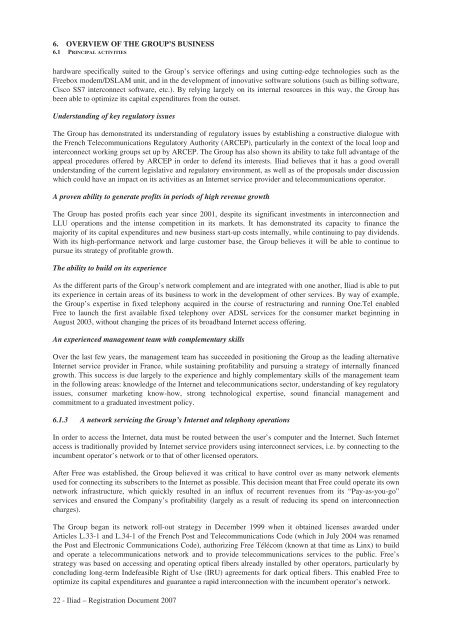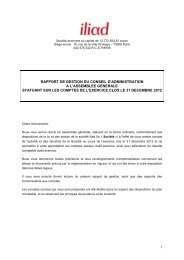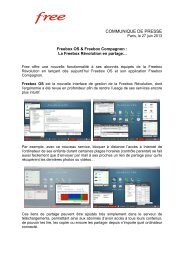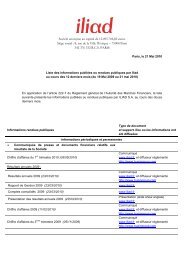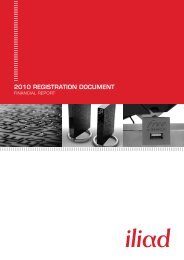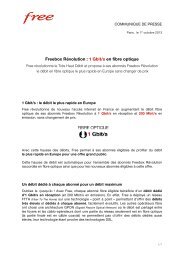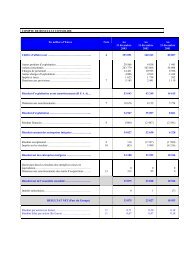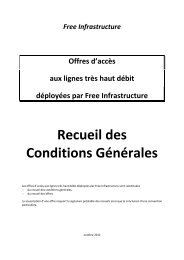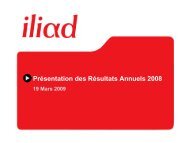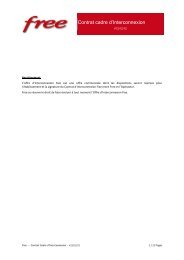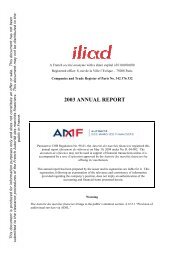REGISTRATION DOCUMENT AND FINANCIAL REPORT - Iliad
REGISTRATION DOCUMENT AND FINANCIAL REPORT - Iliad
REGISTRATION DOCUMENT AND FINANCIAL REPORT - Iliad
- TAGS
- registration
- iliad
- iliad.fr
You also want an ePaper? Increase the reach of your titles
YUMPU automatically turns print PDFs into web optimized ePapers that Google loves.
6. OVERVIEW OF THE GROUP’S BUSINESS<br />
6.1 PRINCIPAL ACTIVITIES<br />
hardware specifically suited to the Group’s service offerings and using cutting-edge technologies such as the<br />
Freebox modem/DSLAM unit, and in the development of innovative software solutions (such as billing software,<br />
Cisco SS7 interconnect software, etc.). By relying largely on its internal resources in this way, the Group has<br />
been able to optimize its capital expenditures from the outset.<br />
Understanding of key regulatory issues<br />
The Group has demonstrated its understanding of regulatory issues by establishing a constructive dialogue with<br />
the French Telecommunications Regulatory Authority (ARCEP), particularly in the context of the local loop and<br />
interconnect working groups set up by ARCEP. The Group has also shown its ability to take full advantage of the<br />
appeal procedures offered by ARCEP in order to defend its interests. <strong>Iliad</strong> believes that it has a good overall<br />
understanding of the current legislative and regulatory environment, as well as of the proposals under discussion<br />
which could have an impact on its activities as an Internet service provider and telecommunications operator.<br />
A proven ability to generate profits in periods of high revenue growth<br />
The Group has posted profits each year since 2001, despite its significant investments in interconnection and<br />
LLU operations and the intense competition in its markets. It has demonstrated its capacity to finance the<br />
majority of its capital expenditures and new business start-up costs internally, while continuing to pay dividends.<br />
With its high-performance network and large customer base, the Group believes it will be able to continue to<br />
pursue its strategy of profitable growth.<br />
The ability to build on its experience<br />
As the different parts of the Group’s network complement and are integrated with one another, <strong>Iliad</strong> is able to put<br />
its experience in certain areas of its business to work in the development of other services. By way of example,<br />
the Group’s expertise in fixed telephony acquired in the course of restructuring and running One.Tel enabled<br />
Free to launch the first available fixed telephony over ADSL services for the consumer market beginning in<br />
August 2003, without changing the prices of its broadband Internet access offering.<br />
An experienced management team with complementary skills<br />
Over the last few years, the management team has succeeded in positioning the Group as the leading alternative<br />
Internet service provider in France, while sustaining profitability and pursuing a strategy of internally financed<br />
growth. This success is due largely to the experience and highly complementary skills of the management team<br />
in the following areas: knowledge of the Internet and telecommunications sector, understanding of key regulatory<br />
issues, consumer marketing know-how, strong technological expertise, sound financial management and<br />
commitment to a graduated investment policy.<br />
6.1.3 A network servicing the Group’s Internet and telephony operations<br />
In order to access the Internet, data must be routed between the user’s computer and the Internet. Such Internet<br />
access is traditionally provided by Internet service providers using interconnect services, i.e. by connecting to the<br />
incumbent operator’s network or to that of other licensed operators.<br />
After Free was established, the Group believed it was critical to have control over as many network elements<br />
used for connecting its subscribers to the Internet as possible. This decision meant that Free could operate its own<br />
network infrastructure, which quickly resulted in an influx of recurrent revenues from its “Pay-as-you-go”<br />
services and ensured the Company’s profitability (largely as a result of reducing its spend on interconnection<br />
charges).<br />
The Group began its network roll-out strategy in December 1999 when it obtained licenses awarded under<br />
Articles L.33-1 and L.34-1 of the French Post and Telecommunications Code (which in July 2004 was renamed<br />
the Post and Electronic Communications Code), authorizing Free Télécom (known at that time as Linx) to build<br />
and operate a telecommunications network and to provide telecommunications services to the public. Free’s<br />
strategy was based on accessing and operating optical fibers already installed by other operators, particularly by<br />
concluding long-term Indefeasible Right of Use (IRU) agreements for dark optical fibers. This enabled Free to<br />
optimize its capital expenditures and guarantee a rapid interconnection with the incumbent operator’s network.<br />
22 - <strong>Iliad</strong> – Registration Document 2007


